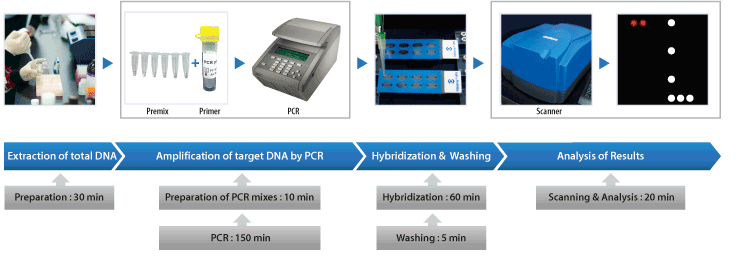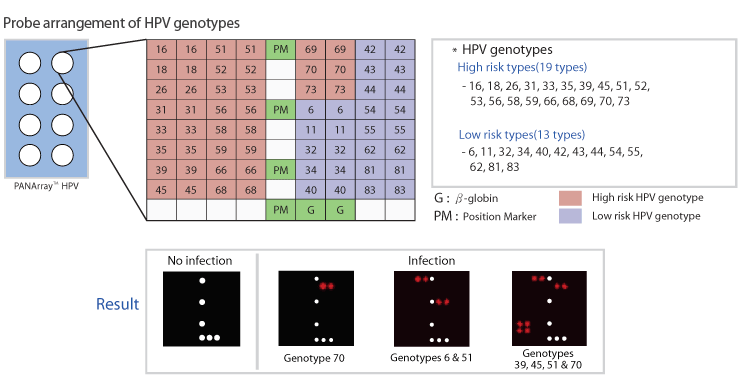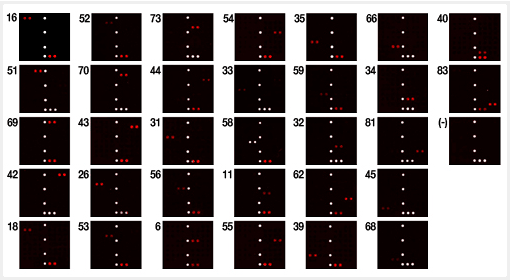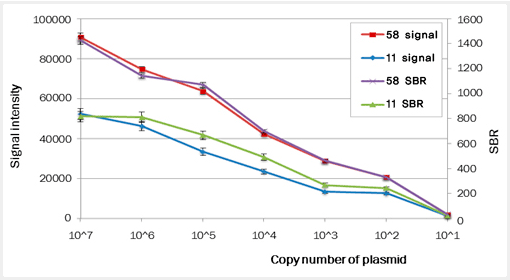 |
According to the WHO report (2008), human papillomavirus (HPV) causes virtually 100% of cases of cervical cancers. There are more than 100 genotypes of HPV reported currently, and HPV consists of double helix circular DNA with ca. 7,900 bp. Compared to the traditional Pap smear test, HPV genotyping has several advantages; 1) high accuracy of determining existence of HPV viruses, 2) genotyping of the HPV viruses, 3) early diagnosis, 4) identifying patients harboring HPV with high risk type, and 5) contribution to prevention and therapy of cervical cancers in the end.
PANArray⑩ HPV Genotyping Chip takes advantages of PNA probe instead of DNA probe. PNA probe is an artificial nucleic acid or DNA analog that has higher binding affinity to its complementary DNA sequences, and faster hybridization reaction than DNA probes. Therefore, the HPV genotyping can be completed in a shorter time with smaller DNA sample. In addition, multiple infections with several HPV genotypes can be precisely identified for diagnosis. Another advantage is its long shelf life even at room temperature because of chemical stability of PNA probes.
|
 |
 |
 |
|
Product Name
|
|
Cat. No.
|
|
Size
|
|
PANArray⑩ HPV Genotyping Chip
|
|
PHP-1001
|
|
96 tests
|
|
|
|
|
|
|
|
|
|
|
|
|
|
 |
 HPV genotyping of 32 types (high risk and low risk groups) HPV genotyping of 32 types (high risk and low risk groups)
|
 Higher specificity and sensitivity than DNA microarrays Higher specificity and sensitivity than DNA microarrays
|
 Longer shelf life over years than DNA microarrays Longer shelf life over years than DNA microarrays
|
 Use of the same scanner used for DNA microarray Use of the same scanner used for DNA microarray
|

|

|
| |
|
|

|
 Images of PANArray⑩ HPV Images of PANArray⑩ HPV
Genotyping Chip were obtained
through 32 HPV subtypes
hybridization.
|
 All HPV specific probes were highly discriminating and did not All HPV specific probes were highly discriminating and did not
cross-hybridize with non specific targets.
|
| |

|
| |
|
|

|
 Standard curves generated for Standard curves generated for
HPV types 11,58.
|
 Dilution series were made with 107 Dilution series were made with 107
to 101 copies.
|
 Each curve is based on an average Each curve is based on an average
of 3 to 5 replicates.
|
 Probe signal intensity values are indicted on the left and sianal to background ratio are indicated on the right. Probe signal intensity values are indicted on the left and sianal to background ratio are indicated on the right.
|
| |
|
| |
 |
| 1 |
Carina et al., The 2010 Global Proficiency Study of Human Papillomavirus Genotyping in Vaccinology. J. Clin. Microbiol. 2012;50(7):2289. |
|
| 2 |
Lee G. et al., THE PREVALENCE OF HUMAN PAPILLOMA VIRUS INFECTIONS ACCORDING TO PAP SMEAR RESULTS IN JEJU ISLAND. Korean J Obstet Gynecol. 2011;54(11):689-695. |
|
| 3 |
Song H. et al., Comparison of the performance of the PANArray⑩ HPV test and DNA chip test for genotyping of human papillomavirus in cervical swabs. BioChip J. 2010;4(3): 167-172. |
|
| 4 |
Choi J. et al., Peptide nucleic acid-based array for detecting and genotyping human papillomaviruses. J Clin Microbiol. 2009;47(6):1785-1790. |
|
|